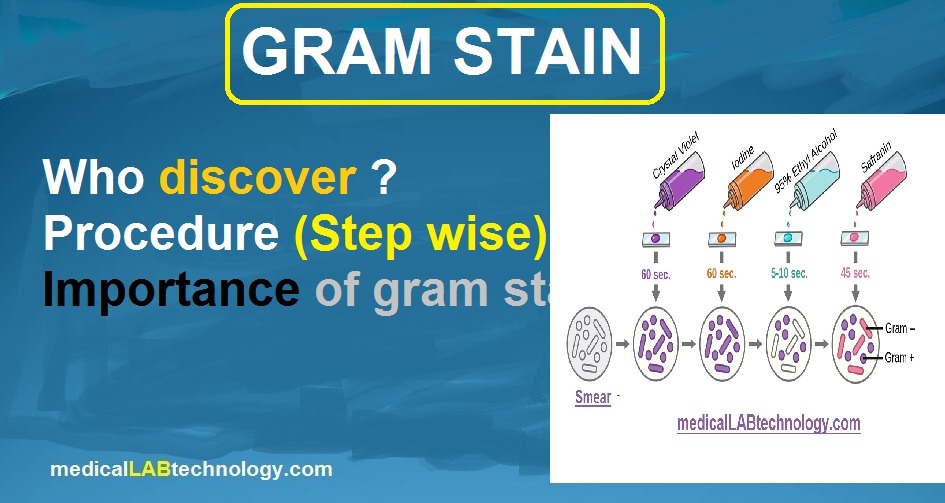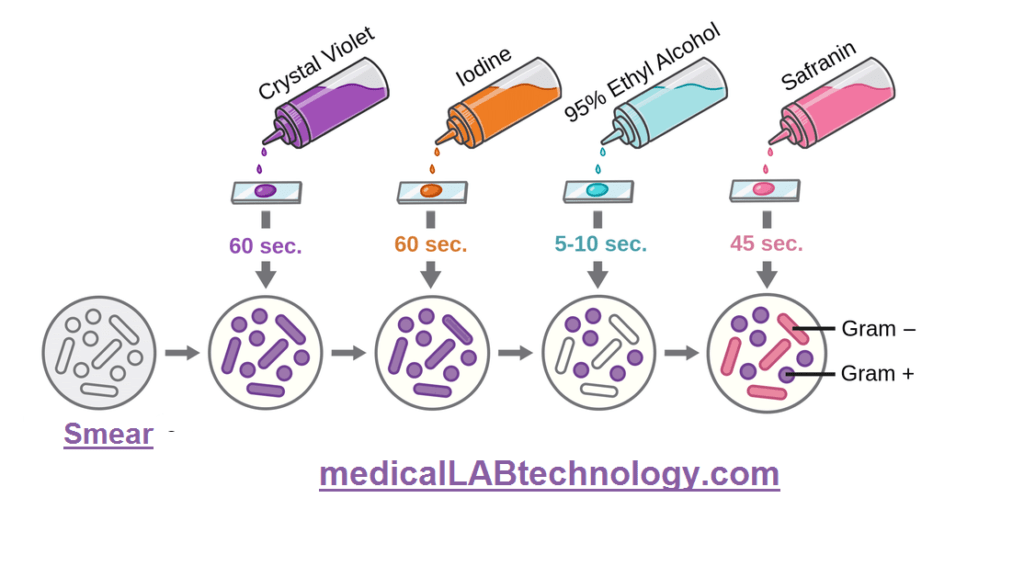Here is the gram staining procedure step-wise.
- STEP 1:first step in gram staining, prepare a smear of the sample (blood, body fluid, pus, culture). Fix it by passing it over the flame.
- STEP 2: Cover the smear with crystal violet stain for 30 to 40 seconds.
- STEP 3: Pour off the stain and cover the smear with Iodine. Allow it for 30 to 40 seconds.
- STEP 4: Pour off the iodine and wash thoroughly with water.
- STEP 5: Counterstain with dilute CARBOL FUCHSIN for 20 seconds.
- STEP 6: Wash with water, blot, and dry.
- STEP 7:See under a microscope.
Gram staining principle
The gram staining technique is based on the variation in cell wall thickness. when a bacterial smear is mixed with a gram stain. Gram-positive bacteria retain crystal violet color due to their cell wall thickness.
While iodine removes the violet stain on gram-negative bacteria (due to less thickness). hence CARBOL FUCHSIN use as a counter stain to visualize the gram-negative bacteria.
Who discovered the gram stain method?
The gram stain method was discovered by the CHRISTIAN GRAM in 1884. Therefore this staining method is named as Gram staining method.
Why do gram-positive bacteria retain crystal violet and not DECOLORSED by the Acetone Iodine?
Gram-positive has a thick cell wall made up of peptidoglycan. Due to the thickness of the wall, they absorb more crystal violet stains as compared to gram-negative bacteria. Gram-negative have less thickness in their cell wall.
when we apply decolorizer on the smear. Gram-negative bacteria are easily washed out but gram-positive bacteria retain crystal violet color.
Why are Gram-negative bacteria Decolorized by the Iodine?
Bacteria cells are up of an outer protective layer called a cell wall. This cell wall is made up of a protein called peptidoglycans. Gram-positive bacteria have a thick layer of peptidoglycan as compared to gram-negative bacteria.
When we apply a crystal violet stain, it is stuck into the cell wall of the cell. Gram +ve bacteria absorb more stain as compared to gram -ve bacteria (this is due to wall thickness). when decolorizer is applied on the smear, it washes gram-negative bacteria (due to less quantity of stain) but gram-positive bacteria retain color (due to wall thickness).
what is the function of iodine solution in gram stain.?
Iodine is the short name of ACETONE IODINE. It acts as DECOLORISER. Iodine was applied after the crystal violet color. Iodine washes violet color from peptidoglycan of the cell wall.
It completely clears gram-negative bacteria due to a wall the thickness of their wall. while gram-positive retain violet color due to more thickness on their cell wall.
What is the Importance of gram staining in microbiology?
There are billions of bacteria on Earth. Many of them are human pathogens and cause mild to severe diseases like typhoid, cholera, leprosy, tuberculosis, syphilis, and many others. Due to the many groups and types of bacteria, it becomes difficult for doctors to identify specific bacteria.
Therefore gram stain is a basic stain for the identification of bacteria. With the help of this stain, we easily diagnose the pathogen, whether the pathogen is gram-positive or gram-negative bacteria.
Gram stain result interpretation
- Gram-Positive bacteria color: Dark Purple or blue
- Yeast cells: Dark purple
- Gram-Negative bacteria color: Pale to Dark red
List of 9 Gram-positive bacteria
- Staph Aureus
- Strep Pneumoniae
- Strept aglectecia
- Enterococci
- Peptostreptococci
- Clostridium
- Corynebacterium
- Listeria
- Bacillus
List of gram-negative bacteria
Here is the list of gram-negative bacteria
- Neisseria meningitidis
- Neisseria Gonorrhoeae
- Hemophilus Influenza
- Brucella
- Bordetella
- E.coli
- Klebsiella
- Enterobacter
- Citrobacter
- Serratia
- Salmonella
- Shigella
- Proteus
- Pseudomonas
- Plesiomonas
How to remove gram stains from clothes
- You should wash your shirt when a stain drops on it.
- Add 2 tablespoons of washing liquid and one tablespoon of white vinegar in hot water.
- Put the cloth in water for 30 minutes.
- After 30 minutes, sponge the stain site with a solution. Flush with clear water.
- If you have a stain, repeat that process until the stain is completely removed.
What are positive and negative controls in Gram staining
- Gram-positive control: Staph
- Gram-negative control:

